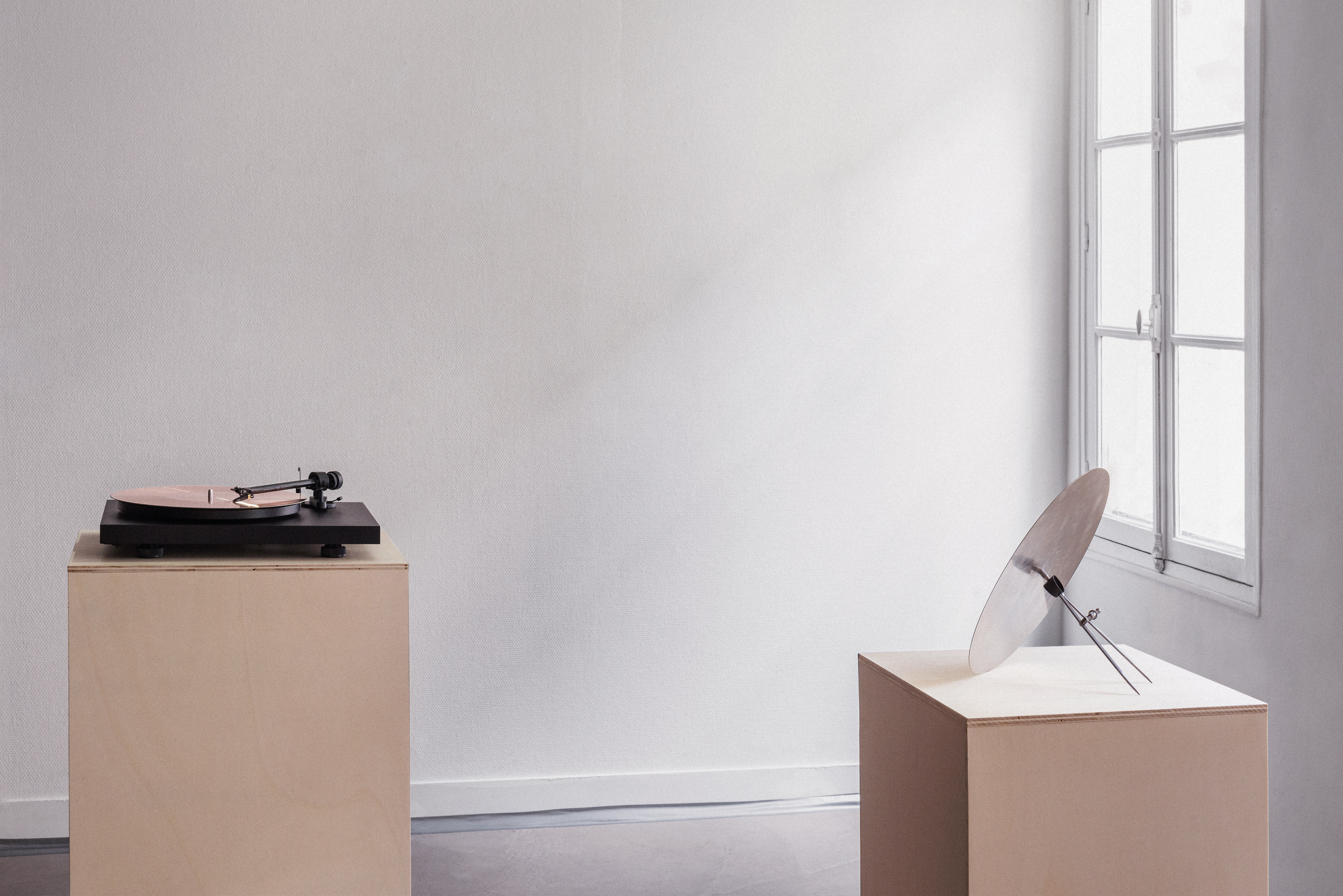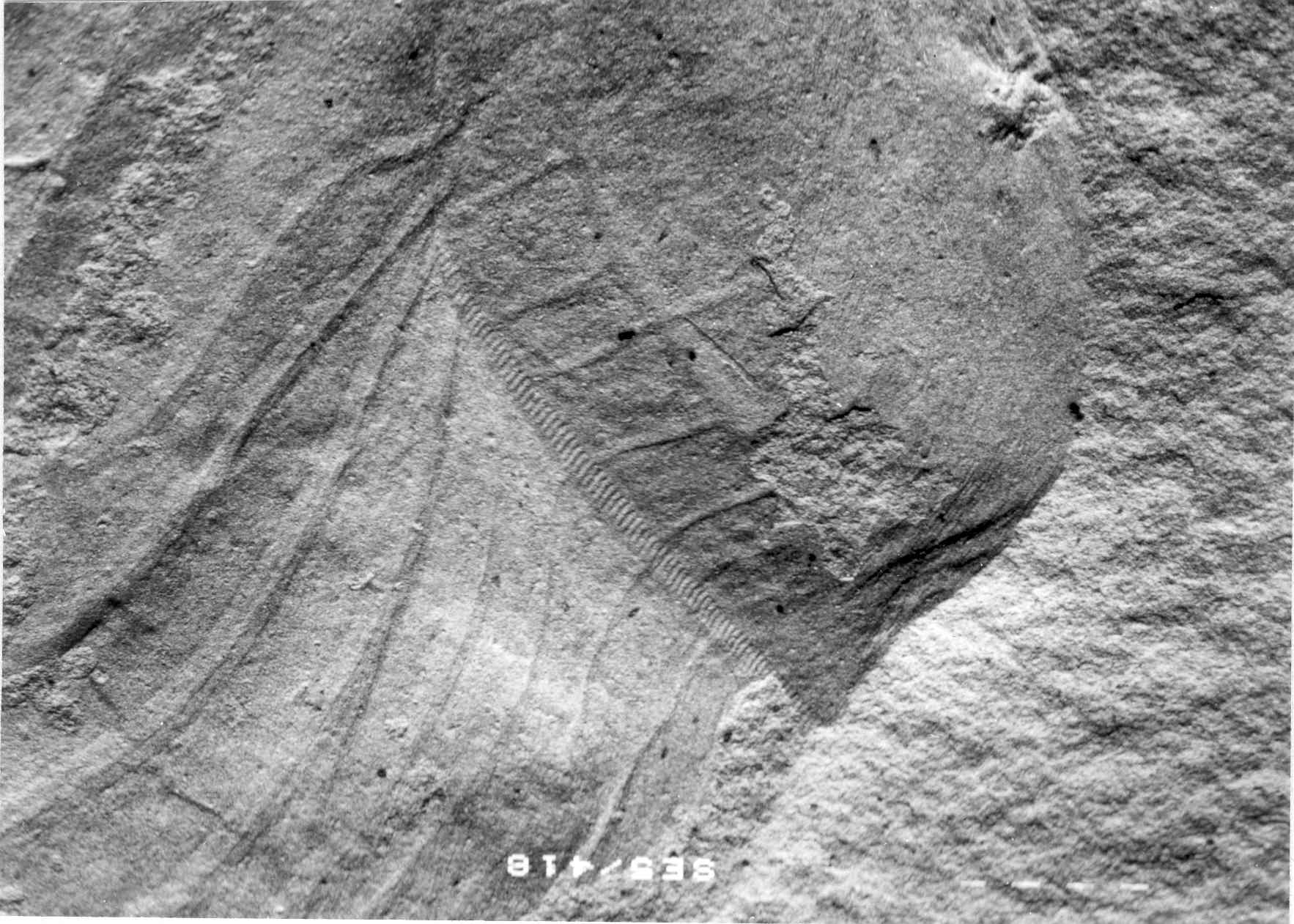|

Robin Meier, 2015 – Steel and copper audio record disk, 30cm diameter, 33rpm, 10 minutes 8 seconds.
Galerie Laurent Mueller, from Mai 15 to June 15 2015
Curated by Marguerite Pilven
Fossil Records is a reconstruction of the sounds emitted by a fossilised insect. By creating a digital model of a highly detailed fossil’s stridulatory file its sound was made to come alive again and was then printed on a playable steel/copper disk in reference to the Golden Record on NASA’s voyager space probe: A record playing sounds from millions of years ago – in symmetry to a future civilisation discovering the Voyager space probe millions of years from now.
[FR] Musicien de formation, Robin Meier mène depuis plusieurs années une recherche de nature éthologique axée sur l’intelligence comme capacité d’interagir avec l’environnement. Il crée notamment des dispositifs lui permettant d’établir une communication avec le règne animal par l’adresse de signaux sonores, mais aussi de simuler ou de modifier son comportement.
Si le monde du signe et de l’artifice distingue traditionnellement l’homme de l’animal, Robin Meier revient sur ce critère d’évolution pour l’explorer et l’interroger. Par les dispositifs qu’il met en place, l’animal devient cet “autre” avec lequel il établit un échange à travers l’étude de ses comportements et de son langage.
Il n’est à ce titre pas anodin que Robin Meier ait utilisé la banque sonore du Golden Record dans le cadre de l’une de ses recherches. Ce disque embarqué par laNasa à bord des sondes spatiales Voyager contient des sons enregistrés sur terre choisis pour leur caractère “universel”. Destiné à d’éventuelles formes de consciences extra-terrestres, il est surtout une invitation à interroger notre vision anthropocentrique du monde en élargissant le spectre de notre rapport à l’Autre, à l’inconnu.
La recherche “paléo-acoustique” qu’il réalise pour le Studio en emprunte le caractère utopique fondé sur une possibilité de rencontre défiant l’espace et le temps. Robin Meier analyse et interprète musicalement la stridulation d’un insecte d’époque préhistorique à partir des nervures de ses ailes visibles sur un fossile.
“La première possibilité pour que Voyager passe par une planète potentiellement habitée sera dans plusieurs millions d’années – un temps après lequel une bonne partie des sons contenus sur ce disque auront disparus sur terre, comme les sons de l’insecte que je reconstruis. Quelque part on se trouve donc dans la situation des extra-terrestres retrouvant Voyager ! Par ailleurs la méthode de production sonore de ces insectes, appelée stridulation, ressemble dans le principe tout à fait à ce que fait un tourne-disque dont l’aiguille est mise en vibration par les sillons du disque. J’aime ce double parallèle que je voudrais mettre en œuvre pour l’incarnation physique de ce projet.”
Marguerite Pilven, 2015

Fossil Records a été conçu avec l’aide de:
– Stefano Delle Monache, sonic interaction designer and assistant professor at the Department of Architecture and Arts, Iuav University of Venice, Italy
– the skatvg.eu project consortium for the Sound Design Toolkit
– Fernando Montealegre Zapata, Lecturer and assistant professor at the Bioacoustics and Sensory Biology lab, Lincoln UK
– Adrian Riffo, mastering
– Anne Becker, production
Image credit:
– Olivier Béthoux, Musée National de l’Histoire Naturelle, Paris, France
– Edmund Jarzembowski, Postgraduate Research Institute for Sedimentology, University of Reading
[EN]
Robin Meier is a trained musician who since several years has been conducting ethological research based on intelligence and its capacity to interact with the environment. For example he creates devices allowing him to establish communication with the animal kingdom through sound signals, but also to simulate or alter its behaviour.
Although traditionally the world of signs and artifice does distinguish man from animals, Robin Meier revisits this evolution criterion in order to explore and examine it. In his setups, animals become this “other” with whom he establishes an exchange via the study of their behaviours and language.
In this respect the fact that Robin Meier uses the Golden Record’s sound bank within the framework of some of his research is highly significant. This record taken by NASA onboard the Voyager II space probe contains sounds recorded on Earth and chosen for their “universal” characteristics. Aimed at possible forms of extra-terrestrial consciousness, it is above all an invitation to question our anthropocentric vision of the world by broadening the spectrum of our relationship to the Other and the unknown.
The “paleo-acoustic” research that he creates for the Studio borrows from it the utopian characteristic based on a possible encounter that defies space and time. Robin Meier musically analyses and interprets the stridulation of a prehistorical insect from the visible veins of a fossil.
“The first possibility for Voyager to pass by a potentially inhabited planet wouldn’t be until several million years from now – a time after which a substantial part of the sounds contained on the record will have disappeared from Earth, like the sounds of the insects that I have ben recreating. It is somehow a situation where aliens would find Voyager! Besides, the method of sound production of these insects is called stridulation and in principle really resembles what a record player sounds like when its grooves start making the needle vibrate. I like this double parallel and I want to implement it for the physical incarnation of this project”.
Marguerite Pilven, 2015
Related
|
Pingback: 11th Shanghai Biennale | robin meier